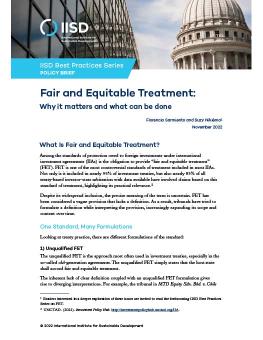
Fair and Equitable Treatment: Why it matters and what can be done
IISD Best Practices Series
FET is one of the most controversial standards of treatment included in most IIAs. Yet, despite its widespread inclusion, the precise meaning of the term is uncertain, and there are different problems associated with FET. The present policy brief highlights the importance of the FET standard and provides policy options that can be considered by policy-makers when negotiating or renegotiating IIAs.
-
Our latest policy brief highlights the importance of the #FET standard and provides policy options that can be considered by policy-makers when negotiating or renegotiating #IIAs.
-
#FET is one of the most controversial standards included in most IIAs and invoked in the vast majority of known #ISDS cases. There are different policy actions and options that governments may consider to preserve their right to regulate and avoid ISDS claims. Check out our latest policy brief to know more.
-
Based on the analysis of treaty practice and jurisprudence, one thing is certain: states should pay special attention to the standard of treatment clause when negotiating or renegotiating #IIAs. Carefully drafted #FET provisions in new agreements should be accompanied by policy steps targeting existing IIAs in place, which often include unqualified FET clauses. Policy options are available in our latest policy brief.
The main takeaways from this brief can be summarized as follows:
- FET is one of the most controversial standards included in most IIAs and invoked in the vast majority of known ISDS cases.
- There are several problems associated with FET. These include the fact that the same standard has led to divergent interpretations, the wide array of measures that can potentially be considered as a breach of the obligation, and the regulatory chill effect it provokes.
- Based on the analysis of treaty practice and jurisprudence, one thing is certain: states should pay special attention to the standard of treatment clause when negotiating or renegotiating IIAs.
- There are different policy actions and options that governments may consider to preserve their right to regulate and avoid ISDS claims, such as excluding the FET clause from their IIAs, including an alternative to the standard that does not refer to the terms “fair and equitable,” or including a well-defined and limited FET standard.
- Carefully drafted FET provisions in new-generation agreements should be accompanied by policy steps targeting existing IIAs in place, which often include unqualified FET clauses.
Participating experts
You might also be interested in
Compensation Under Investment Treaties: What are the problems and what can be done?
In this brief, the authors explore the subject of compensation under investment treaties, as well as options for reform, drawing from their analysis in a related longer paper.
IISD Best Practices Series: Compensation Under Investment Treaties
This paper from IISD's Best Practices series takes a deep dive into the legal principles, arbitral jurisprudence, and lessons learned from how compensation is treated in investor–state arbitration, while presenting possible options for reform.
IISD Best Practices Series: The Most-Favoured-Nation Clause in Investment Treaties
This IISD Best Practices paper studies the most-favoured-nation (MFN) clause in investment treaties and its interpretation by arbitral tribunals, drawing lessons for states.
IISD Best Practices Series: Exhaustion of Local Remedies in International Investment Law
Part of IISD’s Best Practices Series, this advisory bulletin reviews state-of-the-art options and approaches to the exhaustion of local remedies requirement in international investment law.